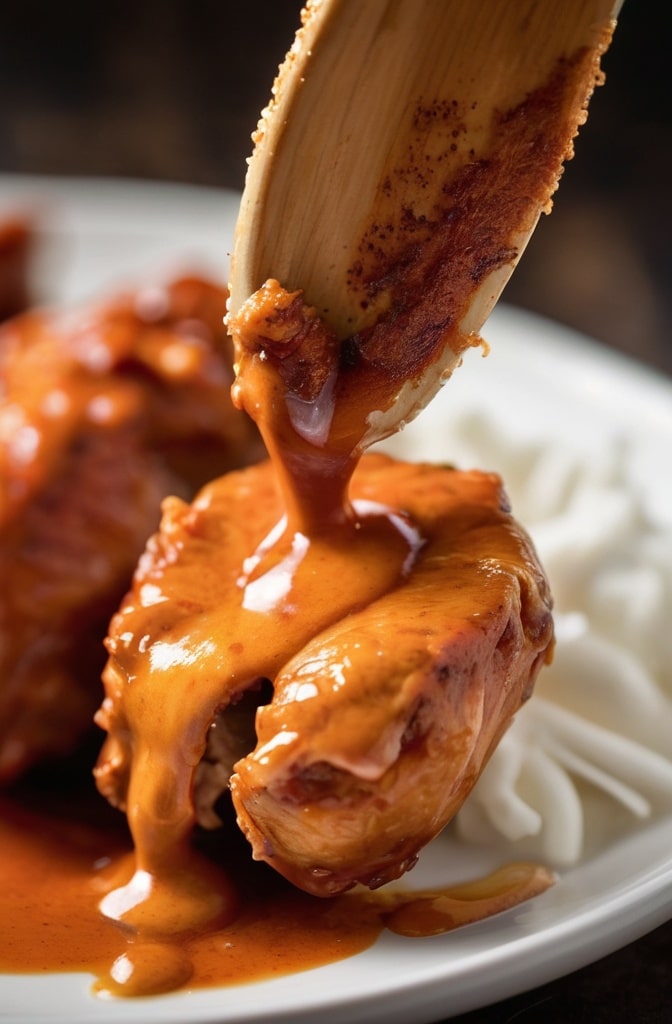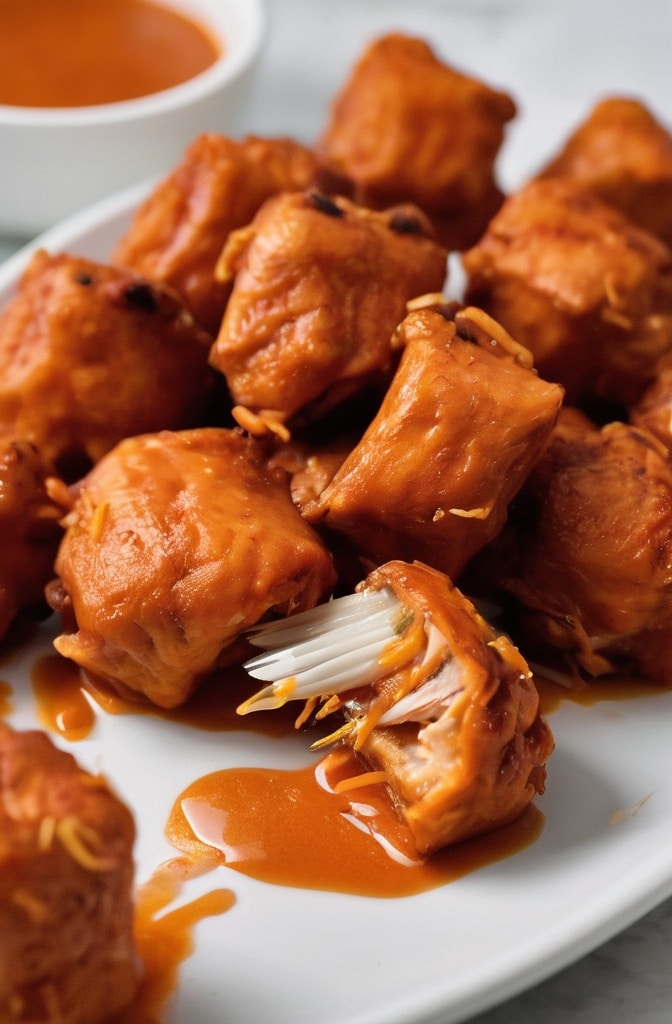The first time I served these Cajun Buffalo Chicken Bites at a Saints game watch party, I witnessed a minor miracle complete silence fell over the room for about 30 seconds. Just the sound of chewing and the occassional satisfied groan. That’s when I knew I’d stumbled onto something special.
Y’ever notice how the most memorable dishes often come from culinary collisions? These chicken bites represent exactly that kind of happy accident the bold, earthy heat of Louisiana Cajun seasoning meeting the vinegary kick of Buffalo sauce. It’s a match that shouldn’t work on paper but creates pure magic on the palate. What makes these bites extraordinary isn’t just their knockout flavor profile, but their versatility and crowd-pleasing potential they’re equaliy at home on a fancy charcuterie board as they are in a game day spread.
Ingredients & Substitutions

For the Chicken Base:
- 2 pounds boneless, skinless chicken thighs (cut into 1-inch cubes)
- 1 cup buttermilk
- 2 large eggs, beaten
- 1½ cups all-purpose flour
- ½ cup cornstarch
- 2 tablespoons Cajun seasoning (homemade preferred)
- 1 teaspoon baking powder
- 1 teaspoon kosher salt (plus more to taste)
- ½ teaspoon freshly ground black pepper
- Vegetable oil for frying (about 2-3 cups)
For the Cajun Buffalo Sauce:
- ⅔ cup Frank’s RedHot Original hot sauce (or your preferred Buffalo sauce)
- ½ cup unsalted butter
- 2 tablespoons honey
- 1 tablespoon Cajun seasoning
- 2 cloves garlic, minced
- 1 tablespoon Worcestershire sauce
- Juice of ½ lemon
For Serving:
- Blue cheese or ranch dressing
- Celery sticks
- Carrots sticks
- Fresh parsley or green onions, chopped
Let’s talk substitutions cuz we all find ourselves in a pinch sometimes. Chicken breast can replace thighs, but I’ll warn ya—they dry out faster and lack the natural richness that makes this dish sing. If you’re dairy-free, replace buttermilk with 1 cup coconut milk mixed with 1 tablespoon lemon juice. The texture will be slightly different, but the function of tenderizing remains.
For gluten-sensitive folks, sub in cup-for-cup gluten-free flour blend plus an extra ¼ teaspoon of xanthan gum to help with binding. Cornstarch is your friend here—it creates that shatteringly crisp exterior we’re after. Don’t skimp on it.
Regarding Cajun seasoning—store-bought works in a crisis, but homemade delivers superior flavor without the obscene sodium levels and anti-caking agents. My base recipe includes paprika, garlic powder, onion powder, dried oregano, dried thyme, cayenne, and black pepper. The freshness difference is no joake.
Step-by-Step Instructions
Preparing the Chicken:
- Place chicken cubes in a large bowl, season with a pinch of salt and pepper, then pour buttermilk over top. Give everything a good toss to ensure complete coverage. Let this mixture marinate for at least 30 minutes, though 2 hours or even overnight in the refrigerator will yield even more tender results.
- When you’re ready to cook, drain the chicken in a colander, giving it a gentle shake to remove excess buttermilk. Don’t rinse! That clingy buttermilk helps your coating adhere better.
- Set up your dredging station: one shallow bowl with beaten eggs, another with the flour mixture (flour, cornstarch, 2 tablespoons Cajun seasoning, baking powder, salt, and pepper). Whisk the dry ingredients thoroughly to ensure even distribution of seasonings.
One of the deadliest mistakes home cooks make is overcrowding when coating the chicken. Work in batches of about 6-8 pieces at a time. Dip each buttermilk-soaked chicken piece first in egg wash, then into the flour mixture, pressing gently to ensure complete adhesion. For extra crunch—and trust me, you want this—double-dip: back into the egg and again into the flour.
Place the coated pieces on a wire rack set over a baking sheet and let them rest for about 10 minutes. This resting period allows the coating to bond to the chicken and absorbs moisture, resulting in less splatter during frying and better adhesion of your delicious crust.
Frying the Chicken:
- Heat oil in a large, heavy-bottomed Dutch oven or deep cast-iron skillet to 350°F (175°C). Use a thermometer here—temperature precision separates good fried chicken from transcendent fried chicken. Too cool, and you’ll get greasy chicken; too hot, and you’ll burn the exterior before the interior cooks through.
- Working in batches (never crowding the pan!), carefully add chicken pieces to the hot oil. Fry for about 5-7 minutes, turning occasionally, until golden brown and crispy. The internal temperature should reach 165°F (74°C). I’ve forgoten my thermometer before, and regretted it this isn’t the place to guess.
- Using a slotted spoon or spider strainer, transfer the fried chicken bites to a paper towel-lined plate or another wire rack. Season immediately with a light sprinkle of salt while still hot.
For a slightly healthier but still crispy version, you can air-fry these babies at 400°F (200°C) for about 12-15 minutes, turning halfway through. You’ll need to spray them generously with oil first. The result isn’t identical to deep-frying but comes surprisingly close with a fraction of the oil.
Preparing the Cajun Buffalo Sauce:
- In a small saucepan, melt butter over medium-low heat. Add minced garlic and cook for about 30 seconds, just until fragrant. Don’t brown it—we want its pungent flavor, not its bitter notes.
- Whisk in the hot sauce, honey, Cajun seasoning, and Worcestershire sauce. Bring mixture to a gentle simmer, then reduce heat and cook for about 5 minutes, stirring occasionally.
- Remove from heat and stir in lemon juice. The sauce should be smooth, glossy, and coat the back of a spoon. If it seems too thin, simmer for a few more minutes; if too thick, add a splash of water.
A crucial variation some Buffalo purists swear by: add a tablespoon of white vinegar for extra tang. Personally, I find the lemon juice provides sufficient acidity, but this is where you can play with the flavor to match your preference. For a sweeter profile, bump up the honey to 3 tablespoons.
Bringing It All Together:
- In a large bowl, gently toss the fried chicken bites with about half the Cajun Buffalo sauce, adding more as needed to reach your desired level of sauciness. Keep some sauce reserved for dipping or for those who like thier bites extra saucy.
- Transfer to a serving plate and garnish with chopped parsley or green onions for a pop of color and freshness.
Cooking Techniques & Science
Let’s talk food science for a moment what makes these bites so irresistible isn’t just the flavor combination but the textural contrast we’ve engineered. The buttermilk soak serves two critical functions: its lactic acid tenderizes the chicken protein by gently breaking down tough connective tissues, while its thick consistency helps the coating adhere.
The addition of cornstarch to flour is no random choice. Cornstarch inhibits some of the gluten formation in flour, creating a more delicate, crispy exterior. Meanwhile, the baking powder might seem like an odd ingredient, but it’s actually genius—as the chicken fries, the baking powder releases tiny carbon dioxide bubbles that create micro-gaps in the crust, resulting in that coveted extra-crunchy texture.
Temperature control is paramount when deep-frying. Maintaining 350°F (175°C) ensures that the exterior browns at the same rate the interior cooks. If your oil temperature drops too low—which happens when you add cold chicken or overcrowd the pan—the coating absorbs excess oil instead of instantly creating that crisp barrier. This is why a deep-fry thermometer isnt just helpful, it’s essential.
The marriage of Buffalo sauce and Cajun seasoning works on a molecular level. Traditional Buffalo sauce combines the capsaicin heat from hot peppers with fat from butter, which helps distribute that heat across your palate rather than concentrating it in one burning spot. The Cajun elements add complex layers of earthy, aromatic compounds that complement rather than compete with the vinegary punch of the Buffalo base. It’s culinary symbiosis at its finest.
Cast iron is my vessel of choice for frying these chicken bites. Its excellent heat retention helps maintain consistent oil temperature, especially when adding batch after batch of cold chicken. If you don’t have a Dutch oven or cast-iron skillet, any heavy-bottomed pot will work, but avoid thin aluminum pans which create hot spots and uneven cooking.
Serving & Pairing Suggestions

Presentation matters almost as much as flavor. For casual gatherings, pile these golden-red beauties high in a bowl lined with parchment paper, with celery and carrot sticks jutting out like edible garnishes. For more upscale affairs, arrange them on a slate board with small ramekins of extra sauce and blue cheese dressing, garnished with micro greens or edible flowers.
Speaking of blue cheese—while traditionalists might insist it’s the only proper accompaniment for anything Buffalo-flavored, I find a good homemade ranch works brilliantly too, especially when spiked with fresh herbs. The coolness of either dressing provides perfect counterpoint to the spicy, vinegary chicken.
Beverage pairings can elevate these bites from merely delicious to truly memorable. Beer enthusiasts should reach for a crisp American pale ale or a wheat beer, whose slight sweetness balances the heat beautifully. Wine lovers should consider an off-dry Riesling or a fruity Zinfandel that can stand up to the bold flavors without being overwhelmed. For non-alcoholic options, nothing beats a tart lemonade or a creamy, malted vanilla milkshake—trust me on that last one, the combination is revelatory.
For a complete meal, these Cajun Buffalo Chicken Bites shine alongside a creamy coleslaw (skip the mayo and try a yogurt-based dressing to keep things light), a basket of sweet potato fries, or a simple green salad with avocado and a light vinaigrette. The key is balance—something creamy, something fresh, something crunchy.
Make-Ahead and Storage Tips
One of this recipe’s hidden superpowers is its make-ahead potential. You can marinate the chicken in buttermilk for up to 24 hours, and the flour mixture can be prepared and stored in an airtight container for weeks.
For the busy entertainer, you can even pre-fry the chicken bites up to a day ahead. Just slightly undercook them (about 1 minute less than you normally would), then cool completely and refrigerate in an airtight container. When ready to serve, reheat in a 375°F (190°C) oven for 7-10 minutes until crispy and heated through, then toss with freshly made sauce.
The Cajun Buffalo sauce itself keeps beautifully in the refrigerator for up to two weeks. Store it in a glass jar and reheat gently before using. The butter may separate when chilled—this is normal and will reincorporate when warmed.
Leftover fully-sauced chicken bites (if such a thing exists!) can be refrigerated for up to 3 days. They won’t retain their original crispness but transform into something equally delicious. Try chopping them up and using as a pizza topping, folding into an omelet, or stuffing into a grilled cheese sandwich.
Beyond the Basics: Creative Variations
Once you’ve mastered the classic version, consider these inspired variations:
Honey Garlic Cajun Bites: Double the honey and garlic in the sauce, reduce the hot sauce by half, and add 2 tablespoons of soy sauce for an Asian-inspired twist.
Smoky Maple Cajun Bites: Replace the honey with pure maple syrup and add 1 teaspoon of liquid smoke to the sauce for a campfire-reminscent flavor profile.
Coconut Curry Cajun Bites: Add 2 tablespoons of yellow curry powder to your flour mixture, and replace half the buttermilk with coconut milk in the marinade. For the sauce, incorporate 2 tablespoons of coconut cream.
Nashville Hot Cajun Bites: After frying, brush the chicken with a mixture of the Cajun Buffalo sauce and 2 tablespoons of melted lard infused with cayenne pepper for that distinctive Nashville heat that lingers gloriously.
Conclusion
These Cajun Buffalo Chicken Bites represent everything I love about modern American cooking—fearless fusion, respect for traditional techniques, and an unwavering commitment to delivering maximum flavor. The magic lies in the details: the double dredge for extra crunch, the precise frying temperature, and that intoxicating sauce that marries two beloved flavor profiles.
What makes this recipe truly special is its adaptability. Master the basic technique, and you can create endless variations to suit any palate or occasion. Don’t be surprised when friends start requesting “those chicken bites” at every gathering—they have a way of developing cult status.
Remember, the most important ingredient here is confidence. Frying can be intimidating, but with attention to temperature and timing, you’ll be rewarded with chicken bites that transcend their humble ingredients. So heat that oil, spice that flour, and prepare to create a new favorite that draws from the best of Louisiana’s diverse culinary heritage.
FAQs
Can I make these Cajun Buffalo Chicken Bites gluten-free?
Absolutely! Substitute the all-purpose flour with a high-quality cup-for-cup gluten-free flour blend. Add an extra tablespoon of cornstarch to enhance crispiness, as gluten-free flours sometimes produce a slightly different texture. Also double-check your Worcestershire sauce, as some brands contain gluten. For the complete gluten-free experience, serve with a gluten-free blue cheese or ranch dressing.
My sauce separated and looks oily. How can I fix it?
Sauce separation typically occurs when butter isn’t properly emulsified or when the sauce is overheated. To rescue a broken sauce, remove it from heat immediately and whisk in 1-2 teaspoons of cold water. Alternatively, transfer to a blender and pulse briefly to re-emulsify. For future batches, make sure to keep your heat low when adding butter, and whisk constantly until fully incorporated.
How can I adjust the spice level while maintaining the flavor balance?
For milder bites that still pack flavor, reduce the Cajun seasoning by half and use a medium-heat Buffalo sauce (or dilute the hot sauce with a bit more butter). Add an extra tablespoon of honey to temper the heat. Conversely, for fire-seekers, double the Cajun seasoning in the flour mixture, add 1 teaspoon of cayenne to the sauce, and consider using ghost pepper hot sauce in place of traditional Buffalo sauce but proceed with caution!
Can I bake these instead of frying for a healthier version?
Yes, though the texture will differ slightly. Preheat your oven to 425°F (220°C). Place the coated chicken pieces on a wire rack set over a baking sheet (the elevation is crucial for all-around crispiness). Spray or brush the pieces generously with oil. Bake for about 15-18 minutes, turning halfway through, until golden brown and reaching an internal temperature of 165°F (74°C). The coating won’t be quite as shatteringly crisp as deep-fried, but still deliciously crunchy with significantly less oil.
My coating keeps falling off during frying. What am I doing wrong?
This common frustration usually stems from one of three issues: First, ensure your chicken is thoroughly dried before dipping in buttermilk. Second, don’t skip the resting period after coating those 10 minutes allow the coating to adhere properly. Finally, check your oil temperature; if it’s not hot enough (at least 350°F/175°C), the coating can become soggy and slide off before setting. Remember also to handle the chicken minimally once in the oil excessive turning can dislodge the coating.

